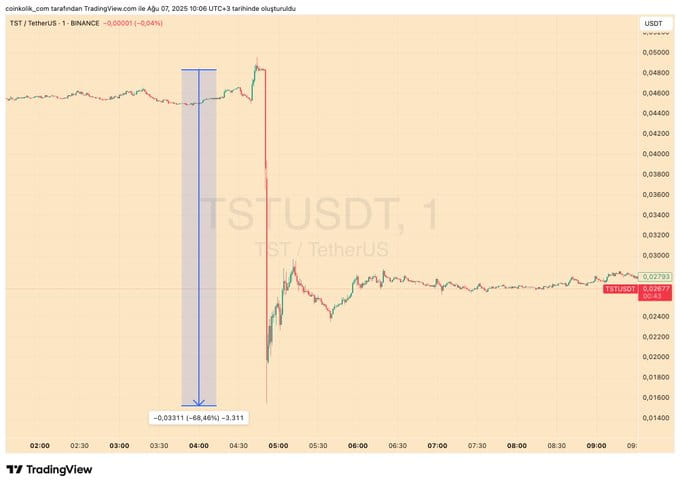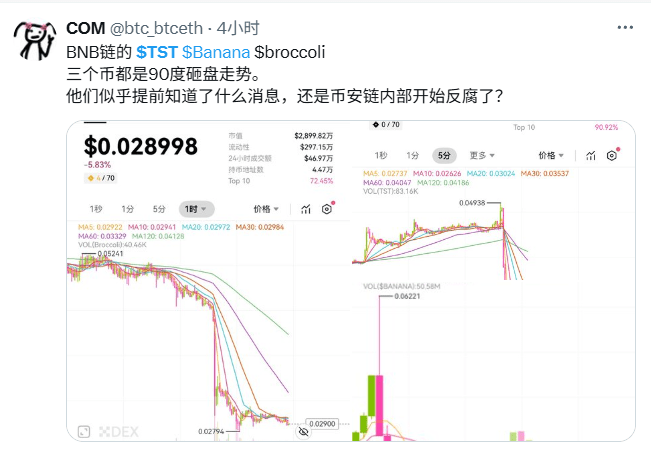Written by: Oliver, Mars Finance
On the morning of August 7, 2025, as Asian traders just switched on their screens, a chill pierced the summer humidity. A cryptocurrency token named Test (TST) saw its K-line chart plummet like a cliff within just one hour, crashing from a still-warm $0.0496 to a cold $0.01547, a nearly 70% drop. Panic spread through the market like a plague, and the TST/USDT trading pair on Binance contributed an astonishing $15.95 million in trading volume during the crash period.
However, the main character of this bloodbath is not some star public chain or DeFi giant. Its name—'Test'—is like a dark humor, revealing the absurd nature behind this storm. This was not an accident, but a textbook-style 'contract slaughter' directed by human greed, algorithmic coldness, and structural defects in the market.

An unexpected solo act: The absurd origins of TST.
TST did not arise from some grand technical vision or a rigorous white paper. Its life began with a teaching video from the BNB Chain team. To demonstrate how their Meme token issuance platform 'four.meme' works, the team created this example token named 'Test.' An unintentional act, yet due to a contract address accidentally leaked in the video, this specimen that should have remained in the laboratory was thrust onto the noisy stage by speculators.
'Related to Binance/BNB Chain'—this vague yet enticing label became the fuel for TST's price surge. In the crypto world, narrative often matters more than reality. The community and sharp-eyed KOLs (key opinion leaders) quickly seized this story and packaged it as a 'community-driven' Meme miracle. Suddenly, discussions about TST went viral on social media. Many investors didn't even know its origin, only that it was a 'value trough' associated with a giant.
This is a classic portrayal of the Meme token 'attention economy.' Its value does not derive from technology or application, but from the sum of community sentiment and social media heat. As pointed out in an analysis by Gate.io, the price curve of such tokens follows a predictable life cycle: 'hype - skyrocketing - consolidation - crash.' After TST was listed in early February 2025, its price skyrocketed by 1100%, perfectly embodying this cycle. However, when the attention recedes, the castle built on quicksand is bound to collapse; it's just a matter of time. Former Binance CEO Zhao Changpeng (CZ) personally clarified that TST had no direct association with the official entity, but this faint voice of reason has long been drowned out by the market's frenzied noise.
'The meat grinder' starts: a review of that heart-stopping hour.
The flash crash on the morning of August 7 was not merely market panic; it resembled a precise surgical operation. The core of this operation was the linkage mechanism of 'spot market slamming and contract explosion.'
Step one: The probing of the whales and the resonance of algorithms.
The storm begins with a tiny disturbance. On-chain data shows that TST's chips are highly concentrated, with a few 'whale' addresses holding enough tokens to shake the market. On the eve of the crash, it is likely that one or more giant whales decided to end this game. They started to continuously sell on the spot market, using the already fragile liquidity of TST on decentralized exchanges (DEX) like PancakeSwap—previously, its liquidity pool totaled only about $3.3 million—to create the first wave of price decline.
This first wave of selling pressure was like a stone thrown into a calm lake, creating intense ripples. Numerous high-frequency trading (HFT) algorithms lurking in the market were instantly activated. When the price fell below a certain key technical support level, these pre-set programs automatically executed stop-loss and liquidation orders. A user on platform X, @bitfoxdotai, analyzed later: 'Cascading long liquidations led to liquidity exhaustion.' This accurately described the scene at the time: the cold execution of machines replaced human hesitation, and selling pressure was geometrically amplified, forming a merciless algorithmic echo chamber.
Step two: The ultimate harvesting of the contract market.
If the sell-off in the spot market is the fuse that ignites the explosion, then the real powder keg is the highly-leveraged derivatives market. Within 24 hours of the flash crash, the trading volume of the TST/USDT contract pair across the network reached an astonishing $266 million, an increase of 1173%. The increase in contract trading volume on Binance was even more jaw-dropping at 1855%. Behind these cold figures lies the tragic tale of countless leveraged long positions.

This is a typical 'long squeeze.' Manipulators create price drops in the spot market, with the real goal of triggering long positions in the contract market that are chasing the price. When the spot price touches the 'liquidation line' of these positions, the exchange's risk engine automatically sells their positions at market price to collect margin. This batch of new, massive sell orders passively crashes into the market, causing further price declines and triggering more long liquidations at lower price levels.
This is a self-reinforcing death spiral. The total contract positions across the network plummeted by 28.86% within that 24 hours, meaning nearly one-third of leveraged positions in the market were cleared amidst their wails. A trading analysis application on platform X, @AlvaApp, commented: 'The MACD indicator confirmed a risk-averse sentiment; leverage was cleared.' TST's contract market transformed into a highly efficient 'meat grinder' that morning.
Reflections on the Ruins: Systemic Cracks Through TST
The tragedy of TST lies in the fact that it is not an isolated performance. Shortly after the flash crash occurred, a screenshot from user @btc_btceth on platform X circulated widely in the community. The image showed the K-line charts of $TST, Banana, and Broccoli—three Meme coins on the BNB chain—side by side, and their trends were remarkably consistent—all showing almost 90-degree vertical crashes. The poster couldn't help but raise a thought-provoking question: 'Did they seem to know some news in advance, or is there an internal anti-corruption effort starting within the Binance chain?'

Speculations about 'internal anti-corruption' may be difficult to confirm, but this chart undoubtedly reveals a more disturbing truth: the collapse of TST may merely be the tip of the iceberg of a collaborative action or cascading failure in the BNB Chain Meme coin ecosystem. This is no longer just a single project issue, but a concentrated exposure of systemic cracks across the entire ecosystem.
First, it exposed the B-side of 'low-barrier innovation.' The BNB Chain's four.meme platform was originally intended to lower the threshold for token issuance and stimulate grassroots innovation. However, this convenience also means a lack of risk control. When a token with no actual value and poor liquidity management is easily created and pushed to the market, it leaves a huge backdoor for potential manipulation. If there can be a TST, there can naturally be countless 'Banana' and 'Broccoli' waiting to be harvested by the same methods.
Secondly, it rings the alarm for DEX liquidity once again. Decentralized exchanges bring permissionless trading freedom, but often come with issues of insufficient liquidity depth. For assets like TST, which have a small market cap and shallow trading depth, a large order from a whale is enough to collapse the entire buy side. When this risk exists simultaneously across multiple tokens, any single point's collapse can trigger a chain reaction across the entire sector due to the contagion of market sentiment.
On a deeper level, we can see echoes of history. Although the mechanisms are more complex, the epic collapse of LUNA/UST in 2022 was similarly rooted in a system with internal mechanism flaws, caught in an inescapable death spiral under external pressure. Whether it's the de-pegging of algorithmic stablecoins or the contract slaughter of Meme coins, they point to a common tragedy: when an asset's value entirely depends on fragile consensus rather than solid value support, its collapse is inevitable; it's just a matter of time and method.
Conclusion: The absurd drama comes to an end, and the warning bell tolls.
The story of TST began with a teaching accident and ended in a market massacre, filled with absurd drama. It provided a public lesson on risk for all market participants in the most brutal way.
The core of this lesson is: when a Meme concept with no intrinsic value meets a highly leveraged derivatives market that can infinitely amplify risk, what they create is an extremely unstable financial 'explosive device.' For ordinary investors, trying to build wealth on this quicksand is akin to courting disaster.
In the end, this farce leaves us with not only the shocking scar on the K-line chart but also the somewhat ironic response from former CEO Zhao Changpeng—who denied any direct association with the project. The creators have long since left the stage, but the monster birthed by the market has already devoured the hard-earned money of countless individuals. The bell for TST has tolled, warning future participants to clearly see beneath their feet as they chase the next hundredfold coin myth—whether it is solid ground or a bottomless abyss.




